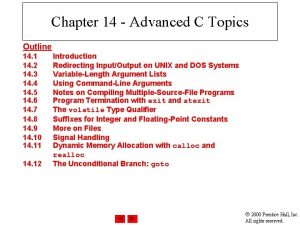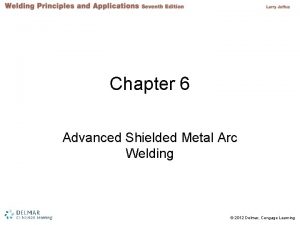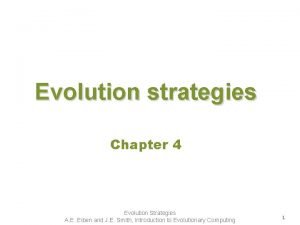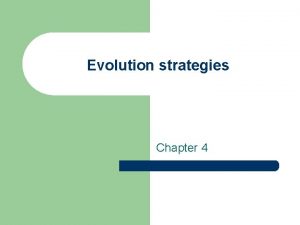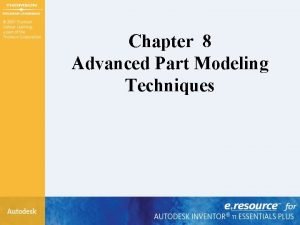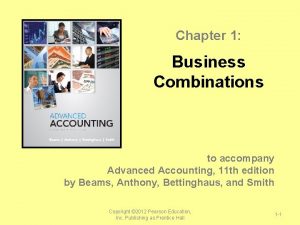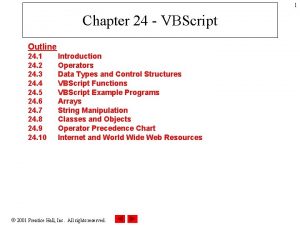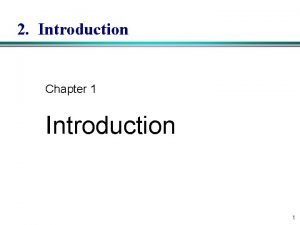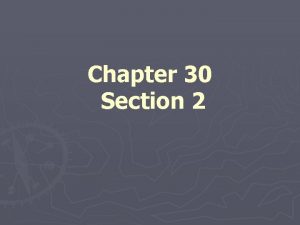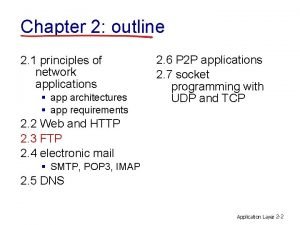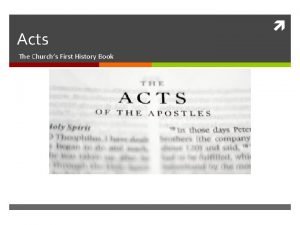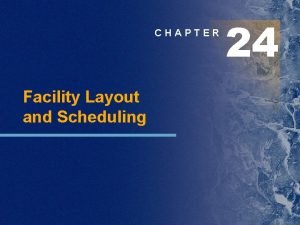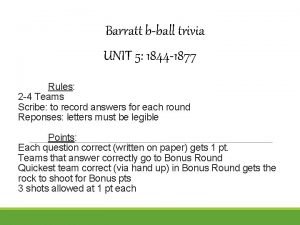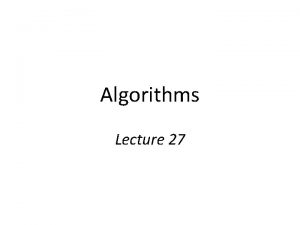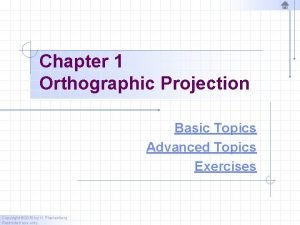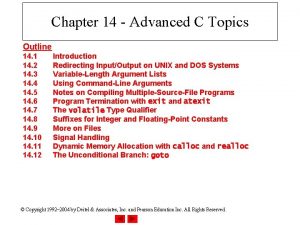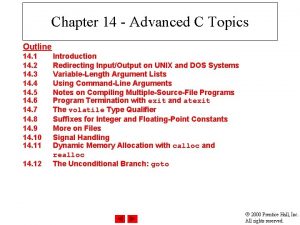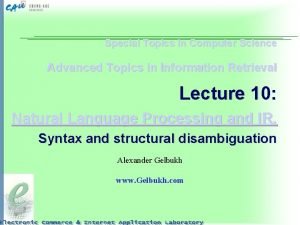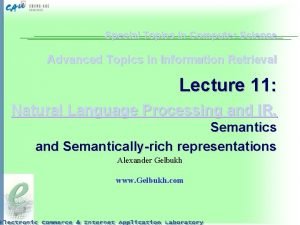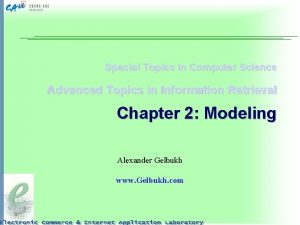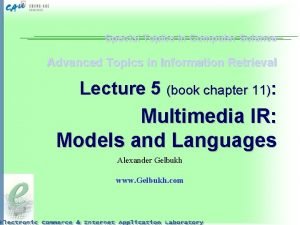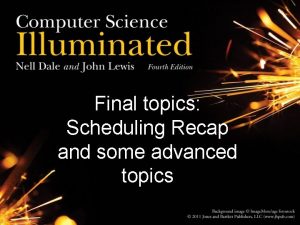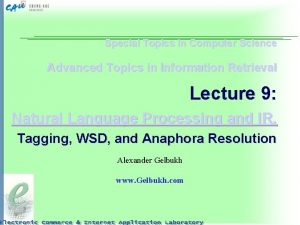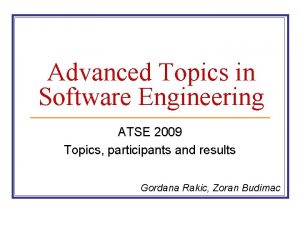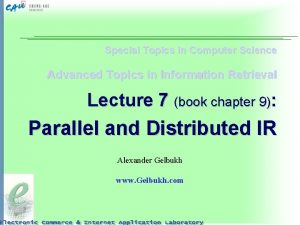Chapter 14 Advanced C Topics Outline 14 1










![Notice argc and argv[] in main Outline fig 14_03. c (Part 1 of 2) Notice argc and argv[] in main Outline fig 14_03. c (Part 1 of 2)](https://slidetodoc.com/presentation_image_h2/da06551781c0f3477b2fbda92e329fef/image-11.jpg)






















- Slides: 33

Chapter 14 - Advanced C Topics Outline 14. 1 14. 2 14. 3 14. 4 14. 5 14. 6 14. 7 14. 8 14. 9 14. 10 14. 11 14. 12 Introduction Redirecting Input/Output on UNIX and DOS Systems Variable-Length Argument Lists Using Command-Line Arguments Notes on Compiling Multiple-Source-File Programs Program Termination with exit and atexit The volatile Type Qualifier Suffixes for Integer and Floating-Point Constants More on Files Signal Handling Dynamic Memory Allocation with calloc and realloc The Unconditional Branch: goto © Copyright 1992– 2004 by Deitel & Associates, Inc. and Pearson Education Inc. All Rights Reserved.

Objectives • In this chapter, you will learn: – To be able to redirect keyboard input to come from a file. – To be able to redirect screen output to be placed in a file. – To be able to write functions that use variable-length argument lists. – To be able to process command-line arguments. – To be able to assign specific types to numeric constants – To be able to use temporary files. – To be able to process unexpected events within a program. – To be able to allocate memory dynamically for arrays. – To be able to change the size of memory that was dynamically allocated previously. © Copyright 1992– 2004 by Deitel & Associates, Inc. and Pearson Education Inc. All Rights Reserved.

14. 1 Introduction • Several advanced topics in this chapter • Operating system specific – Usually UNIX or DOS © Copyright 1992– 2004 by Deitel & Associates, Inc. and Pearson Education Inc. All Rights Reserved.

14. 2 Redirecting Input/Output on UNIX and DOS Systems • Standard I/O - keyboard and screen – Redirect input and output • Redirect symbol(<) – Operating system feature, not a C feature – UNIX and DOS – $ or % represents command line – Example: $ sum < input – Rather than inputting values by hand, read them from a file • Pipe command(|) – Output of one program becomes input of another $ random | sum – Output of random goes to sum © Copyright 1992– 2004 by Deitel & Associates, Inc. and Pearson Education Inc. All Rights Reserved.

14. 2 Redirecting Input/Output on UNIX and DOS Systems • Redirect output (>) – Determines where output of a program goes – Example: $ random > out • Output goes into out (erases previous contents) • Append output (>>) – Add output to end of file (preserve previous contents) – Example: $ random >> out • Output is added onto the end of out © Copyright 1992– 2004 by Deitel & Associates, Inc. and Pearson Education Inc. All Rights Reserved.

14. 3 Variable-Length Argument Lists • Functions with unspecified number of arguments – – Load <stdarg. h> Use ellipsis(. . . ) at end of parameter list Need at least one defined parameter Example: double myfunction ( int i, . . . ); – The ellipsis is only used in the prototype of a function with a variable length argument list – printf is an example of a function that can take multiple arguments – The prototype of printf is defined as int printf( const char* format, . . . ); © Copyright 1992– 2004 by Deitel & Associates, Inc. and Pearson Education Inc. All Rights Reserved.

14. 3 Variable-Length Argument Lists © Copyright 1992– 2004 by Deitel & Associates, Inc. and Pearson Education Inc. All Rights Reserved.

Outline fig 14_02. c (Part 1 of 2) © Copyright 1992– 2004 by Deitel & Associates, Inc. and Pearson Education Inc. All Rights Reserved.

Outline fig 14_02. c (Part 2 of 2) w x y z = = 37. 5 22. 5 1. 7 10. 2 The average of w and x is 30. 000 The average of w, x, and y is 20. 567 The average of w, x, y, and z is 17. 975 © Copyright 1992– 2004 by Deitel & Associates, Inc. and Pearson Education Inc. All Rights Reserved. Program Output

14. 4 Using Command-Line Arguments • Pass arguments to main on DOS or UNIX – Define main as int main( int argc, char *argv[] ) – int argc • Number of arguments passed – char *argv[] • Array of strings • Has names of arguments in order – argv[ 0 ] is first argument – Example: $ mycopy input output • • argc: argv[ 3 0 ]: “mycopy" 1 ]: "input" 2 ]: "output" © Copyright 1992– 2004 by Deitel & Associates, Inc. and Pearson Education Inc. All Rights Reserved.
![Notice argc and argv in main Outline fig 1403 c Part 1 of 2 Notice argc and argv[] in main Outline fig 14_03. c (Part 1 of 2)](https://slidetodoc.com/presentation_image_h2/da06551781c0f3477b2fbda92e329fef/image-11.jpg)
Notice argc and argv[] in main Outline fig 14_03. c (Part 1 of 2) argv[1] is the second argument, and is being read. argv[2] is the third argument, and is being written to. Loop until End Of File. fgetc a character from in. File. Ptr and fputc it into out. File. Ptr. © Copyright 1992– 2004 by Deitel & Associates, Inc. and Pearson Education Inc. All Rights Reserved.

Outline fig 14_03. c (Part 2 of 2) © Copyright 1992– 2004 by Deitel & Associates, Inc. and Pearson Education Inc. All Rights Reserved.

14. 5 Notes on Compiling Multiple-Source. File Programs • Programs with multiple source files – Function definition must be in one file (cannot be split up) – Global variables accessible to functions in same file • Global variables must be defined in every file in which they are used – Example: • If integer flag is defined in one file • To use it in another file you must include the statement extern int flag; – extern • States that the variable is defined in another file – Function prototypes can be used in other files without an extern statement • Have a prototype in each file that uses the function © Copyright 1992– 2004 by Deitel & Associates, Inc. and Pearson Education Inc. All Rights Reserved.

14. 5 Notes on Compiling Multiple-Source. File Programs • Keyword static – Specifies that variables can only be used in the file in which they are defined • Programs with multiple source files – Tedious to compile everything if small changes have been made to only one file – Can recompile only the changed files – Procedure varies on system • UNIX: make utility © Copyright 1992– 2004 by Deitel & Associates, Inc. and Pearson Education Inc. All Rights Reserved.

14. 6 Program Termination with exit and atexit • Function exit – Forces a program to terminate – Parameters – symbolic constants EXIT_SUCCESS or EXIT_FAILURE – Returns an implementation-defined value – Example: exit( EXIT_SUCCESS ); • Function atexit( function. To. Run ); – Registers function. To. Run to execute upon successful program termination • atexit itself does not terminate the program – Register up to 32 functions (multiple atexit() statements) • Functions called in reverse register order – Called function cannot take arguments or return values © Copyright 1992– 2004 by Deitel & Associates, Inc. and Pearson Education Inc. All Rights Reserved.

Outline fig 14_04. c (Part 1 of 2) © Copyright 1992– 2004 by Deitel & Associates, Inc. and Pearson Education Inc. All Rights Reserved.

Outline fig 14_04. c (Part 2 of 2) Program Output Enter 1 to terminate program with function exit Enter 2 to terminate program normally : 1 Terminating program with function exit Executing function print at program termination Program terminated Enter 1 to terminate program with function exit Enter 2 to terminate program normally : 2 Terminating program by reaching the end of main Executing function print at program termination Program terminated © Copyright 1992– 2004 by Deitel & Associates, Inc. and Pearson Education Inc. All Rights Reserved.

14. 7 The volatile Type Qualifier • volatile qualifier – Variable may be altered outside program – Variable not under control of program – Variable cannot be optimized © Copyright 1992– 2004 by Deitel & Associates, Inc. and Pearson Education Inc. All Rights Reserved.

14. 8 Suffixes for Integer and Floating-Point Constants • C provides suffixes for constants – unsigned integer – u or U – long integer – l or L – unsigned long integer – ul, lu, UL or LU – float – f or F – long double – l or L – Examples: 174 u 467 L 3451 ul – If integer constant is not suffixed type determined by first type capable of storing a value of that size (int, long int, unsigned long int) – If floating point not suffixed of type double © Copyright 1992– 2004 by Deitel & Associates, Inc. and Pearson Education Inc. All Rights Reserved.

14. 9 More on Files • C can process binary files – Not all systems support binary files • Files opened as text files if binary mode not supported – Binary files should be used when rigorous speed, storage, and compatibility conditions demand it – Otherwise, text files are preferred • Inherent portability, can use standard tools to examine data • Function tmpfile – Opens a temporary file in mode "wb+" • Some systems may process temporary files as text files – Temporary file exists until closed with fclose or until program terminates • Function rewind – Positions file pointers to the beginning of the file © Copyright 1992– 2004 by Deitel & Associates, Inc. and Pearson Education Inc. All Rights Reserved.

14. 9 More on Files • File open modes: © Copyright 1992– 2004 by Deitel & Associates, Inc. and Pearson Education Inc. All Rights Reserved.

Outline fig 14_06. c (Part 1 of 2) © Copyright 1992– 2004 by Deitel & Associates, Inc. and Pearson Education Inc. All Rights Reserved.

Outline fig 14_06. c (Part 2 of 2) © Copyright 1992– 2004 by Deitel & Associates, Inc. and Pearson Education Inc. All Rights Reserved.

This program changes tabs to spaces. Enter a file to be modified: data. txt The file before modification is: 0 1 2 3 4 5 6 7 8 Outline 9 The file after modification is: 0 1 2 3 4 5 6 7 8 9 © Copyright 1992– 2004 by Deitel & Associates, Inc. and Pearson Education Inc. All Rights Reserved. Program Output

14. 10 Signal Handling • Signal – Unexpected event, can terminate program • Interrupts (<ctrl> c), illegal instructions, segmentation violations, termination orders, floating-point exceptions (division by zero, multiplying large floats) • Function signal – Traps unexpected events – Header <signal. h> – Receives two arguments a signal number and a pointer to the signal handling function • Function raise – Takes an integer signal number and creates a signal © Copyright 1992– 2004 by Deitel & Associates, Inc. and Pearson Education Inc. All Rights Reserved.

14. 10 Signal Handling • Signals defined in signal. h © Copyright 1992– 2004 by Deitel & Associates, Inc. and Pearson Education Inc. All Rights Reserved.

Outline fig 14_08. c (Part 1 of 3) signal set to call function signal_handler when a signal of type SIGINT occurs. © Copyright 1992– 2004 by Deitel & Associates, Inc. and Pearson Education Inc. All Rights Reserved.

Outline fig 14_08. c (Part 2 of 3) User given option of terminating program © Copyright 1992– 2004 by Deitel & Associates, Inc. and Pearson Education Inc. All Rights Reserved.

Outline fig 14_08. c (Part 3 of 3) Signal handler reinitialized by calling signal again © Copyright 1992– 2004 by Deitel & Associates, Inc. and Pearson Education Inc. All Rights Reserved.

1 2 3 4 5 6 7 8 11 12 13 14 15 16 17 18 21 22 23 24 25 26 27 28 31 32 33 34 35 36 37 38 41 42 43 44 45 46 47 48 51 52 53 54 55 56 57 58 61 62 63 64 65 66 67 68 71 72 73 74 75 76 77 78 81 82 83 84 85 86 87 88 91 92 93 Interrupt signal ( 2 ) received. Do you wish to continue ( 1 = yes 94 95 96 Interrupt signal ( 2 ) received. Do you wish to continue ( 1 = yes 9 19 29 39 49 59 69 79 89 10 20 30 40 50 60 70 80 90 or 2 = no )? 1 or 2 = no )? 2 © Copyright 1992– 2004 by Deitel & Associates, Inc. and Pearson Education Inc. All Rights Reserved. Outline Program Output

14. 11 Dynamic Memory Allocation with calloc and realloc • Dynamic memory allocation – Can create dynamic arrays • calloc( nmembers, size ) – nmembers – number of elements – size of each element – Returns a pointer to a dynamic array • realloc( pointer. To. Object, new. Size ) – – – pointer. To. Object – pointer to the object being reallocated new. Size – new size of the object Returns pointer to reallocated memory Returns NULL if cannot allocate space If new. Size equals 0 then the object pointed to is freed If pointer. To. Object equals 0 then it acts like malloc © Copyright 1992– 2004 by Deitel & Associates, Inc. and Pearson Education Inc. All Rights Reserved.

14. 12 The Unconditional Branch: goto • Unstructured programming – Use when performance crucial – break to exit loop instead of waiting until condition becomes false • goto statement – Changes flow control to first statement after specified label – A label is an identifier followed by a colon (i. e. start: ) – Quick escape from deeply nested loop goto start; © Copyright 1992– 2004 by Deitel & Associates, Inc. and Pearson Education Inc. All Rights Reserved.

Outline Notice how start: , end: and goto are used 1 2 3 4 5 6 7 8 9 10 © Copyright 1992– 2004 by Deitel & Associates, Inc. and Pearson Education Inc. All Rights Reserved. fig 14_09. c Program Output
 Advanced topics in software engineering
Advanced topics in software engineering Angular guard naming convention
Angular guard naming convention Angular advanced topics
Angular advanced topics Advanced c topics
Advanced c topics Advanced topics in web development
Advanced topics in web development Android advanced topics
Android advanced topics Advanced topics in computer science
Advanced topics in computer science In an outline the relationship of topics
In an outline the relationship of topics What is a quote sandwich examples
What is a quote sandwich examples Chapter 9 topics in analytic geometry
Chapter 9 topics in analytic geometry Chapter 6 advanced shielded metal arc welding
Chapter 6 advanced shielded metal arc welding Pseudocde
Pseudocde Advanced evolution chapter 4
Advanced evolution chapter 4 Advanced evolution chapter 8
Advanced evolution chapter 8 Advanced accounting chapter 1
Advanced accounting chapter 1 A repetition of or return to criminal behavior *
A repetition of or return to criminal behavior * Romans outline by chapter
Romans outline by chapter Plan of work and time schedule in research proposal
Plan of work and time schedule in research proposal Give me liberty chapter 27
Give me liberty chapter 27 Secondary data
Secondary data Chapter 38 a world without borders outline
Chapter 38 a world without borders outline 24 chapter outline
24 chapter outline Why has peeta been kept alive by the career tributes
Why has peeta been kept alive by the career tributes Chapter 31 societies at crossroads outline
Chapter 31 societies at crossroads outline General hero
General hero Chapter 2 learning goals outline sociology answers
Chapter 2 learning goals outline sociology answers Chapter 1 outline
Chapter 1 outline Chapter 1 outline
Chapter 1 outline Chapter 30
Chapter 30 Chapter 2 outline
Chapter 2 outline Outline of acts
Outline of acts Government spending multiplier
Government spending multiplier 24 chapter outline
24 chapter outline Forty niners apush
Forty niners apush



